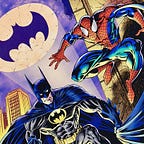The Selected Batman Re-Read, Part Three — The Late Eighties and Early Nineties
After Frank Miller’s takes on Batman, the next decade or so seemed to have a decidedly more “mature” spin on the character. Some of those succeeded to a greater degree than others.
The one that a lot of people would argue did succeed phenomenally is Alan Moore and Brian Bolland’s controversial The Killing Joke, a psychological study of what it takes to drive a man to insanity, as conducted by the Joker. Bolland’s art is absolutely gorgeous here, his line work bringing the characters superbly (and also sombrely and scarily) to life. His colouring in the deluxe edition adds wonderful new depth, with excellent story choices that especially enhance the flashback sequences, making the big reveal of the Joker all the more frightening.
But the story itself… well, Moore has gone on record to say that it’s one of his worst. And, while I find something like Miller’s The Dark Knight Returns more juvenile with the benefit of hindsight, I find The Killing Joke utterly mean-spirited. There are some stories where you’re intended to feel uncomfortable for the sake of driving a message home. There’s no message here, just discomfort.
But the late eighties portion of my re-read wasn’t without a bright spot, so to speak. Arkham Asylum: A Serious House on Serious Earth is an arts house masterpiece.
Grant Morrison’s story, when read on its own, is fine enough, with the Amadeus Arkham bits far outshining the bits with Batman. But like all of Morrison’s work, it’s greatly helped by understanding their intent (which is handily provided in the edition that I own with their commentary on the reprinted script).
Dave McKean’s art is the kind of thing that should be studied. It is indescribably beautiful in its own dark and twisted way, and truly elevates the story to levels far beyond what any other artist could achieve.
Transitioning into the early nineties, we’ve got Dark Knight, Dark City by Peter Milligan and Kieron Dwyer, which is a solid story about the demon that permeates Gotham’s veins. It’s an interesting concept, one that Grant Morrison somewhat returns to during their run in the two thousands, but Milligan’s story, while entertaining and interesting doesn’t really possess much re-readiblity beyond two rounds. His other stories, collected in this volume, likewise are all interesting, but nothing that truly stands out.
Finally, we’ve got JM DeMatteis and Joe Staton’s Going Sane, which actually falls into the Year One canon, but I felt fit better in this post.
The story goes that DeMatteis had actually pitched this story to DC earlier, but was shot down because of its similarities to The Killing Joke. I can see it. Thematically, the idea of Batman and Joker’s eternal dance, the one never being complete without the other, is explored in both stories, but I feel like DeMatteis does it infinitely better than Moore did, infusing this concept with more humanity than Moore’s mean-spiritedness. Granted, Staton’s art, while solidly serviceable, is nowhere near the level of artistry of Bolland’s. And the pacing definitely felt like it could’ve been tighter in places. But that’s not enough to detract from how wonderful a character study this is, harkening back to DeMatteis’ earlier success with the Spider-Man story, “Kraven’s Last Hunt”.
Going Sane is nowhere near the classic that story was, but it’s still a great read and one that, despite it being placed in the Year One canon, feels like it would have had greater resonance if it had been set in the then “current” Batman timeline.
For every one of my criticisms of these stories, each certainly countered with more than enough good. The late eighties/early nineties were a good time for Batman, playing strongly in a sombrely atmospheric space, which no doubt worked well with the tone of the Tim Burton movies and the animated series.
And that’s why, while I didn’t read any of these stories till much later in my life, they certainly resonate with me. This was the Batman I discovered in my formative years, together with Adam West’s take, and I’ll always have a soft spot for this version.
(Originally published on 4 March 2019.)
